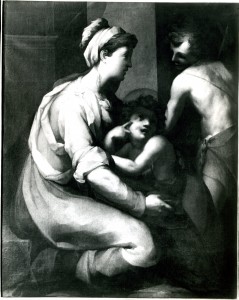Florence, Corsini Gallery, no. 93 (formerly no. 163).
Panel, 87 x 61.
The painting appears almost monochromatic under dark varnish. The children and their garments are shades of brown and tan. The Virgin, with brown hair, has a garment of pink-violet, the same color as the top of her headdress. The bottom of her headdress is whitish gray, as is the drapery across her back. The background is grayish green.
LITERATURE:
Goldschmidt, 1911, 49, as very near to Rosso, around 1522.
Clapp, 1916, as a copy after Pontormo, perhaps by Jacopo da Empoli.
Voss, 1920, I, 189, as perhaps by Rosso.
Kusenberg, 1931, 130, as a copy after Rosso.
Venturi, IX, 5, 1932, 230, as Rosso (?).
Mostra del Cinquecento, 1940, 67, as Rosso, around 1525.
Becherucci, 1944 (1949), 28, as Rosso, of uncertain date.
Barocchi, 1951, 86, 250, Fig. 58, as by an artist of the mid-sixteenth century, perhaps Naldini, and as either a liberal copy after Rosso or an exercise on a Rosso theme.
Cecchi, A., “A proposito del Poppi ‘eccellente pittore diligentissimo e vaghissimo nel colorire,’” Artista, 5, 1993, 71-72, as Poppi after Jacopino del Conte.
Costamagna, 1994, 291-292, A49, Fig., accepts Cecchi’s opinion.
This painting, which had earlier been attributed to Pontormo, would seem to be by Poppi (Francesco Morandini). The faces, the formation of the hands, the angular drapery, and the chiaroscuro can be found in his Resurrection of the Widow’s Son in S. Niccolò, Florence (Fig.Poppi),1 and in such drawings as his Composition with several nude figures in the Louvre (Inv. 9059; Fig.Poppi, Paris, 9059)2 and especially in his Annunciation drawing, in the Fogg Museum, where there are almost identical strands of hair falling upon the Virgin’s neck.

